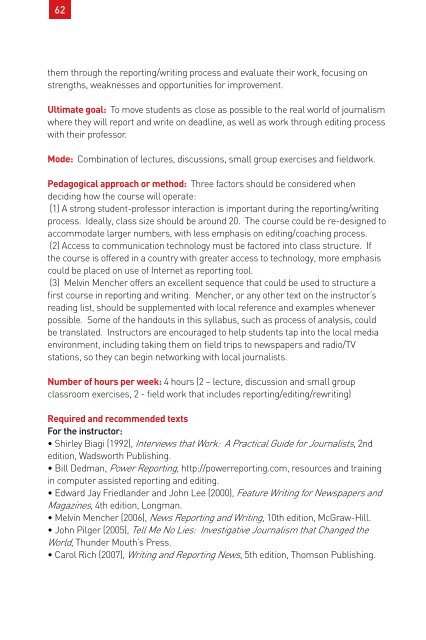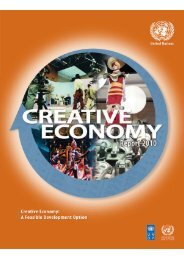Model curricula for journalism education for developing countries ...
Model curricula for journalism education for developing countries ...
Model curricula for journalism education for developing countries ...
You also want an ePaper? Increase the reach of your titles
YUMPU automatically turns print PDFs into web optimized ePapers that Google loves.
62<br />
them through the reporting/writing process and evaluate their work, focusing on<br />
strengths, weaknesses and opportunities <strong>for</strong> improvement.<br />
Ultimate goal: To move students as close as possible to the real world of <strong>journalism</strong><br />
where they will report and write on deadline, as well as work through editing process<br />
with their professor.<br />
Mode: Combination of lectures, discussions, small group exercises and fieldwork.<br />
Pedagogical approach or method: Three factors should be considered when<br />
deciding how the course will operate:<br />
(1) A strong student-professor interaction is important during the reporting/writing<br />
process. Ideally, class size should be around 20. The course could be re-designed to<br />
accommodate larger numbers, with less emphasis on editing/coaching process.<br />
(2) Access to communication technology must be factored into class structure. If<br />
the course is offered in a country with greater access to technology, more emphasis<br />
could be placed on use of Internet as reporting tool.<br />
(3) Melvin Mencher offers an excellent sequence that could be used to structure a<br />
first course in reporting and writing. Mencher, or any other text on the instructor’s<br />
reading list, should be supplemented with local reference and examples whenever<br />
possible. Some of the handouts in this syllabus, such as process of analysis, could<br />
be translated. Instructors are encouraged to help students tap into the local media<br />
environment, including taking them on field trips to newspapers and radio/TV<br />
stations, so they can begin networking with local journalists.<br />
Number of hours per week: 4 hours (2 – lecture, discussion and small group<br />
classroom exercises, 2 - field work that includes reporting/editing/rewriting)<br />
Required and recommended texts<br />
For the instructor:<br />
• Shirley Biagi (1992), Interviews that Work: A Practical Guide <strong>for</strong> Journalists, 2nd<br />
edition, Wadsworth Publishing.<br />
• Bill Dedman, Power Reporting, http://powerreporting.com, resources and training<br />
in computer assisted reporting and editing.<br />
• Edward Jay Friedlander and John Lee (2000), Feature Writing <strong>for</strong> Newspapers and<br />
Magazines, 4th edition, Longman.<br />
• Melvin Mencher (2006), News Reporting and Writing, 10th edition, McGraw-Hill.<br />
• John Pilger (2005), Tell Me No Lies: Investigative Journalism that Changed the<br />
World, Thunder Mouth’s Press.<br />
• Carol Rich (2007), Writing and Reporting News, 5th edition, Thomson Publishing.

















